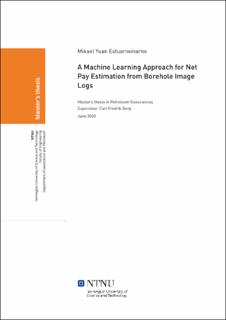| dc.description.abstract | In the realm of hydrocarbon exploration, net pay estimation is essential for the economic calculation and valuation of the field. By definition, net pay is the reservoir interval with economically producible hydrocarbons content. The traditional net pay estimation method involves an interpretation of borehole image logs with a cutoff derived from core data. A cutoff-dependent net pay estimation might inhibit further study of a particular field as the cutoff itself might not be universally reliable for wells or reservoir intervals without core data. In this study, an alternative net pay estimation method based on the implementation of machine learning on borehole image logs interpretation was considered and optimized. The cutoff-independent estimation is achieved through the use of a convolutional neural network (CNN). The convolutional neural network is trained to generate a model which maps the correlation between borehole image logs and net pay fraction from core ultraviolet (UV) photographs.
A convolutional neural network design and data processing procedures from a previous study by the same author were optimized with several optimization approaches, to improve the net pay estimation from borehole image logs. Image logs processing attempted to apply the necessary corrections for an improvement in the image quality. Core UV photographs processing aimed to convert core UV photographs into binarized images from which net pay fraction values were derived. The optimized data processing procedures resulted in several image log datasets and net pay fraction labels based on data from four exploration wells in the Johan Castberg field. A set of net pay estimations with the processed data and optimized CNN were conducted to evaluate the optimized net pay estimation method.
The estimation results showed that the net pay estimation method was able to generate accurate and reliable estimations on unseen image logs. Evaluation of the estimation results proved that the optimization of the net pay estimation method was able to generate a model with more accurate estimations compared to the earlier study. The results also showed that the net pay estimation method has the potential to be implemented in a situation where core information was not available or not reliable. Several limitations of the net pay estimation method were highlighted, i.e. limitation in image logs resolution and model compatibility. Based on the limitations and results evaluation, several recommendations for the continuation of the study were formulated, e.g. utilization of image logs with better quality, the introduction of additional training samples from different wells or fields, and net pay estimations on data from a different field. | |
